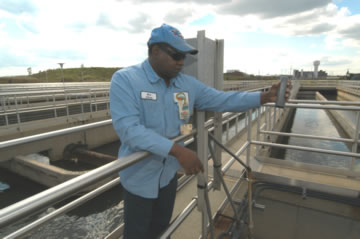


In September 2002, DPW embarked on a $900 million effort to rehabilitate Baltimore's sanitary system. When it was laid out 100 years ago, sanitary pipes were located near the City's streams to take advantage of gravity to transport waste to where it could be pumped to our treatment plants.
Natural biological agents associated with waste constantly attack sewer pipes. Corroded pipe and materials tossed into the system such as oil, rags, and grease can choke the lines and cause an overflow of sewage into our urban streams. Pumping failures can also lead to a discharge into the nearest body of water.
Public Works is going to rehabilitate old sewers through a capital improvement program, implement a maintenance program to prevent overflows, and inspect all of the City's sewer system on a regular basis. This program will be a major step in restoring Baltimore's urban streams and preserving them as natural resources for future generations.
Protecting the Chesapeake
Starting in the mid 1980s, the Patapsco Wastewater treatment plant has been extensively upgraded with the addition of modern processes to remove organic and solid wastes and also to remove nitrogen and phosphorus. Facilities for the removal of nitrogen are under design. Although the nitrogen-removing technology to be used at Patapsco has not been determined, it is estimated the City will spend $150 million to implement it.
The Back River plant removes nitrogen in a process called Biological Nitrogen Removal. Through this process, the plant removes approximately 70% of the influent nitrogen and, through a combination of biological and chemical processes, it removes approximately 96% of the influent phosphorus. Suspended matter and dissolved organic matter (respectively termed Total Suspended Solids and Biochemical Oxygen Demand) are both removed at rates in excess of 98%.
Over the past 10 years, Public Works has invested $500 million into biological nutrient removal in our wastewater facilities to safeguard the waters leading to the Chesapeake. DPW will continue to lead in the efforts to thoroughly treat wastewater before it is returned to the Bay.